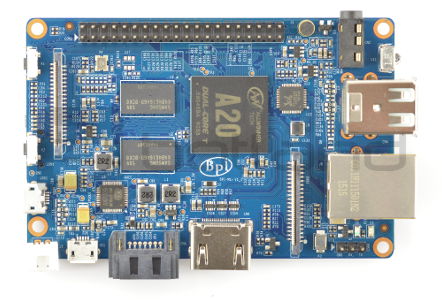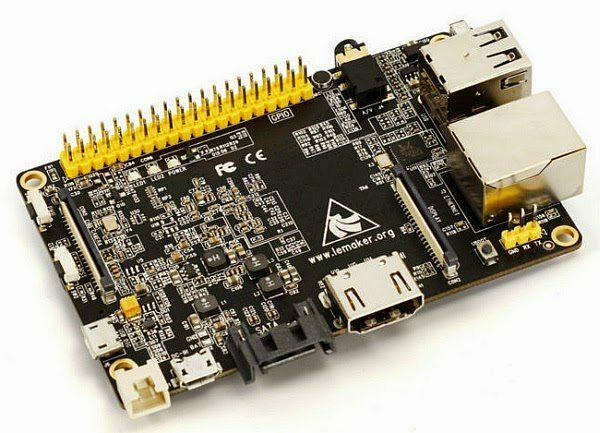After the invasion of the Raspberry Pies there followed a rain of other fruit pies, the Banana Pi the most persistent so far.
Offered by two companies (BPI and Lemaker, who seems to have split up after the intial M1 and R1 models that they made -and still sell- together) they have rows of Banana's waiting for us.
The specs -at least- are good:
| Feature |
Banana Pi M1 |
Banana Pi M1+ |
Banana Pro |
Banana Pi M2 |
Banana Pi M2+ |
Banana Pi M3 |
Banana Pi R1 |
|---|
| Size |
92mm x 60mm |
92mm x 60mm |
92mm x 60mm |
92mm x 60mm |
65mm x 65mm |
92mm x 60mm |
148mm x 100mm |
| SOC |
Allwinner A20 |
Allwinner A20 |
Allwinner A20 |
Allwinner A31s |
Allwinner H3 |
Allwinner A83t |
Allwinner A20 |
| CPU |
ARM Cortex-A7 |
ARM Cortex-A7 |
ARM Cortex-A7 |
ARM Cortex-A7 |
ARM Cortex-A7 |
ARM Cortex-A7 |
ARM Cortex-A7 |
| Architecture |
ARMv7-A |
ARMv7-A |
ARMv7-A |
ARMv7-A |
ARMv7-A |
ARMv7-A |
ARMv7-A |
| Speed |
1000 MHz[/td]
1000 MHz |
1000 MHz |
1200 MHz |
1200 MHz |
1800 MHz |
1000 MHz |
1000 MHz |
| Cores |
2 |
2 |
2 |
4 |
4 |
8 |
2 |
| RAM |
1024 MB |
1024 MB |
1024 MB |
1024 MB |
1024 MB |
2048 MB |
1024 MB |
| RAM/Core |
512 MB |
512 MB |
512 MB |
256 MB |
256 MB |
256 MB |
512 MB |
| USB 2.0 |
2 |
2 |
2 |
4 |
2 |
2 |
2 |
| LAN |
10/100/1000 |
10/100/1000 |
10/100/1000 |
10/100/1000 |
10/100/1000 |
10/100/1000 |
4x 10/100/1000 LAN
1x 10/100/1000 WAN |
| WiFi |
No |
Yes |
Yes |
Yes |
Yes |
Yes |
Yes |
| Bluetooth |
No |
No |
No |
No |
Yes |
Yes |
No |
| SATA |
1x SATA-150 |
1x SATA-300 |
1x SATA-300 |
No |
No |
1x SATA-300 |
1x SATA-150 |
| eMMc |
No |
No |
No |
No |
8GB |
8GB |
No |
| Picture (clickable) |
 |
 |
 |
 |
 |
 |
 |
| Drawing (clickable) |
 |
 |
 |
 |
 |
 |
|
Despite being not as popular as the Raspberries, the Bananas do have some claim to fame.
- The original Banana Pi -now called the M1 and with two improved variants, Pro and M1+ - was a ARMv7 dual core with 1 GB RAM, when the original Raspberry Pi B still was a ARMv6 single core with 512 MB -and the original Raspberry Pi A still was a ARMv6 single core with 256 MB.
- The Banana Pi M2 already was a ARMv7 quad core -with higher clock speed- before the Raspberry Pi 2 arrived.
- The Banana Pi M3 is an ARMv7 octa-core, a feat which Raspberry has not managed -yet.
- The Banana Pi M2+ can be compared with the Raspberry Pi A+ (format-wise), but here the advantage is again with the Banana: it is a ARMv7 quad core with 1 GB RAM, while the Raspberry Pi A+ still is a ARMv6 single core with 256 MB.
Me personally, I am waiting for a Banana Pi R2, featuring all extra's (quad- or octo-core, WiFi, Bluetooth, eMMc, SATA-300).
Rumours are that you really need to cool the M3 to get all eight cores running at 1800 MHz.
Really need as in 'a small heatsink is not enough'.
Example of such a small heatsink (originally meant for the Raspberry Pi A and B):

These do excellent service on my BeagleBone Black at the moment and have a quite fitting colour.
The two biggies being 20x19x5 mm, the small one 8.5x19x5 mm.















